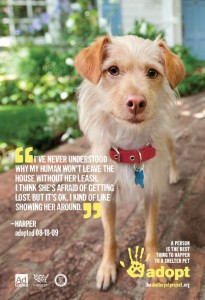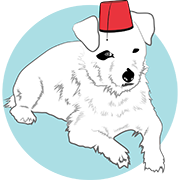“A person is the best thing to happen to a shelter pet. Be that person. Adopt.” — slogan, the Shelter Pet Project
In a three-part series, I’m exploring the Shelter Pet Project, a campaign dedicated to ending the killing of healthy, adoptable pets. These posts are based on my interview with Rich Avanzino, President of Maddie’s Fund, one of the campaign’s co-sponsors, along with the Humane Society of the United States and the Ad Council.
In Part 1, I covered the first phase of the Shelter Pet Project, which produced and distributed a series of videos and ads aimed at changing the perception of shelter pets as being inferior. I also discussed the inclusiveness of the project, its willingness to incorporate a lot of different views and methods to achieve its goals.
Here I continue my conversation with Rich with a discussion of how the project came under the aegis of the Ad Council, as well as the potential impact of getting the Ad Council involved in this cause.
But first…
An introduction to the Ad Council
Started in 1942, the Ad Council is a private non-profit with clout. They wrangle the advertising and communications industries, the media, and the business and non-profit communities into donating their talents and their resources to spread the word about worthy projects of their choice.
 You’re familiar with their work, whether you’re aware of it or not. Public service advertising didn’t really exist before the Ad Council created it during World War II with such campaigns as Rosie the Riveter — designed to get women into the workforce while the men were at war — and the security-oriented “Loose Lips Sink Ships.” Among their iconic slogans: Smokey Bear’s “Only You Can Prevent Forest Fires,” “Friends Don’t Let Friends Drive Drunk,” and “A Mind is a Terrible Thing To Waste,” for the United Negro College Fund. Here’s a link to some of the Ad Council’s classic campaigns (time sink alert: these ads are timeless and fascinating).
You’re familiar with their work, whether you’re aware of it or not. Public service advertising didn’t really exist before the Ad Council created it during World War II with such campaigns as Rosie the Riveter — designed to get women into the workforce while the men were at war — and the security-oriented “Loose Lips Sink Ships.” Among their iconic slogans: Smokey Bear’s “Only You Can Prevent Forest Fires,” “Friends Don’t Let Friends Drive Drunk,” and “A Mind is a Terrible Thing To Waste,” for the United Negro College Fund. Here’s a link to some of the Ad Council’s classic campaigns (time sink alert: these ads are timeless and fascinating).
When the Ad Council chooses to puts its resources behind a cause, you can bet the public will be aware of it.
***
How did the Ad Council come to chose pet adoption as one of its causes?
It started in Chicago in 2007 with Howard Draft, a founder of Draftfcb, one of the world’s largest communications agency networks. A longtime animal lover, Draft was a great supporter of PAWS Chicago, the city’s largest No Kill humane organization, and wondered how he could help the No Kill movement could go national. He was on the board of directors of the Ad Council, and it was his idea to get them involved. It was a little unusual; they had never taken on a project that wasn’t human focused before, but the rest of the board approved it.
PAWS Chicago didn’t have a national outreach, so they thought of Maddie’s Fund, a family foundation established in 1999 to help fund the creation of a No Kill nation. The Ad Council also wanted to have an organization that worked with a greater number of shelters, and selected HSUS as a partner because they have a huge network. With our funding and their network and the Ad Council’s expertise and Draftfcb’s creative talent, it was clear we would have a great partnership.
The campaign started in 2008 and is slated to run for four years, but a lot of the Ad Council’s campaigns, like Smokey Bear [introduced in 1944], are ongoing.
So far, what has this meant?
The fact that the Ad Council chose shelter and rescue adoption to touch the American people’s hearts is huge. There’s nothing that’s even come close in the history of our movement. They have 33,000 media outlets that use their materials to promote the causes highlighted in the campaigns. We think there’s an excellent chance that 3 out of 4 Americans will see one of our four commercials in a month’s time.
We’ve already generated $33 million in donated media. We believe that, with this most recent round of materials, we’ll get even more.
 There’s the talent of Draftfcb of course to convey the messages. [EJ: I’ve included several videos from the first phase of the campaign in part 1, and will include the newest videos in part 3. The two print ads featured on this blog are also part of the latest campaign; be sure to click on them.] And the connections of the Ad Council get us celebrities to work with. We have some of the most talented Hollywood producers and directors, icons in the business, working on our TV spots. The quality of their material and the stature they have within their own industry is a huge leverage in getting our word out about saving animal lives.
There’s the talent of Draftfcb of course to convey the messages. [EJ: I’ve included several videos from the first phase of the campaign in part 1, and will include the newest videos in part 3. The two print ads featured on this blog are also part of the latest campaign; be sure to click on them.] And the connections of the Ad Council get us celebrities to work with. We have some of the most talented Hollywood producers and directors, icons in the business, working on our TV spots. The quality of their material and the stature they have within their own industry is a huge leverage in getting our word out about saving animal lives.
Even our animal actors are of the highest caliber; they’re part of the celebrity core of Hollywood animal actors, they are all paid. [EJ: I forgot to ask if they have a union and if they earn equity wages]. They’re also all from shelters. We made it clear that we wanted the best but that they all had to be shelter animals.
How does this translate into action?
It’s said that sex and pets and children are the three things that always demand immediate attention from the public. We have one of those three things; we just have to do a better job getting the message out about shelter pets.
It’s not so much that we’re going to get $40 or 50 million dollars of donated ad space, though of course that’s very helpful. It’s that we hope to tap into the conversations that people have with their neighbors, on blogs [EJ: Done!], at the dog park… that’s where movements begin and flourish, survive and thrive. Some 14 million people — a million more than Starbucks has customers — have adopted from shelters and believe that shelters are the best and the only place to get companion animals from. We want to put a megaphone in each of their hands so they can tell the story about why they’re so thrilled about their shelter pets. We’re in a powerful position. We just have to motivate people who want to do the right thing but don’t know how to go about doing it.

‘Rescued’ dogs are often perceived as inferior by people because of their personal experiences with an adopted dog. I have lost count of the number of people who have told me they will never adopt a dog from a shelter again because of a bad, often heart breaking, experience they had with a dog they got from a shelter. I am referring to behavioral problems, not medical ones.
Until the people responsible for placing dogs in homes are able to make better assessments of dogs and are realistic in regard to which home is appropriate, shelter dogs will continue to be seen as inferior IMHO.
You’re right, Debbie, that’s part of a very complex equation that I’m going to touch upon in Part 3: The responsibility of shelters to the pets they adopt out. For one thing, it’s important to make shelters into places that won’t drive animals crazy; that’s being done with programs like Open Paw. For another, as you say, behavioral assessments are essential. Again, some shelters have instituted the ASPCA’s Meet Your Match program. Not enough, however. The point, however, is that these animals are not inherently inferior; they’ve been made so by a dysfunctional system. And the solution is certainly not to kill all of them.
Another great installment. I’m looking forward to Part 3 as well.
I love this series. I love the Ad Council as well as the Shelter Pet Project. Thanks for explaining!
You’re welcome. I’m glad you’re enjoying it.
This series is terrific. Debbie is spot on. We who adopt out dogs or cats need to ensure our adopters know, as much as possible, into what they are getting. I offer “weekend trials” for some dogs and I know my collegial no kill does the same.
Giving people who have had a good experience adopting a pet a megaphone is a great mission. I don’t disagree with Debbie, but I think that those people imagine if they’d gotten a puppy from a breeder he/she wouldn’t have any behavioral problems. We need for people to understand that any dog can have issues – you’re no more likely to get a perfect dog from a breeder than you are from a shelter.
You’re so right, Amy. It just occurred to me re: no guarantees — just ask Deborah Flick (boulderdog.net), whose very fearful poodle Sadie came from a very good breeder.
I like very much their slogan, finding the best person who will give love to these dogs whoa re searching for a family. To @Debbie, I also knew some people who has this skeptic feeling of adopting a dog from the shelter due to the history they have been, but I also knew a lot of people who are getting along so fine with the dogs they adopted. It just takes time before they get used to with their new environment and give their 100% trust, that is why it is a must that the family show love and care once they took it home.
I know we are thrilled with our shelter pet (well, from a rescue organization if that counts). After we adopted, we learned of the scandalous story of how she ended up there (think shady alley deals and forged documents). Now look at her – she’s a star. We would be glad to share our story if asked. I already do share our story with “neighbors” who read our blog and members of our Adventureweiner Club of Seattle.